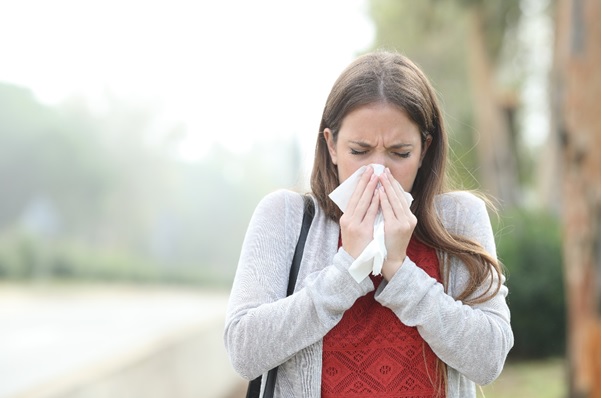 Life & Style
Life & Style


|
| Dr Mattias Larsson. Photo courtesy of Family Medical Practice |
Dr Mattias Larsson*
Working as a doctor in Việt Nam, when asking about allergies, I often get the answer that the patients suffer from “weather allergy” – does it exist? Can weather cause allergies?
To start with, we need to assess – what is an allergy? Allergic symptoms appear when the body’s immune system is reacting to a foreign substance.
The immune system produces antibodies that identify a particular foreign substance as harmful, even though it isn't. Symptoms of an allergic reaction depend on the substance involved and can affect your airways, sinuses and nasal passages, skin, and digestive system.
Allergic reactions can range from mild to severe. In severe cases, allergies can trigger an anaphylactic shock, a life-threatening medical emergency, with symptoms including light-headedness, skin rash, shortness of breath, nausea and vomiting, drop in blood pressure, rapid, weak pulse and loss of consciousness.
The most common allergic symptoms include: Hay fever or allergic rhinitis with sneezing, itching of the nose and eyes, runny, stuffy nose and red or swollen eyes. Atopic dermatitis or eczema, can cause itch, rash, flake or peel. Food allergy with tingling in the mouth, swelling of the lips, tongue, face or throat, hives and, in severe cases, anaphylaxis.
Drug allergy with hives, itchy skin, rash, facial swelling, wheezing and anaphylaxis. An insect sting allergy causes swelling at the sting site, itching or hives all over the body, cough, chest tightness, wheezing or shortness of breath and anaphylaxis.
While most allergies can't be cured, treatments can help relieve your allergy symptoms. Understanding what causes your allergies will help you avoid reactions more predictably.
Weather changes introduce new or increased concentrations of allergens in the air, triggering reactions in people allergic to those specific allergens. During dry, windy days, pollen and other allergens cause allergic rhinitis and other respiratory reactions. On rainy, humid days, mould will thrive, both inside the home and outside, as well as dust mites, another common allergen. However, humid air weighs down pollen, so if you have a pollen allergy, these days might be better for you.

|
| The most common allergic symptoms include hay fever or allergic rhinitis with sneezing, itching of the nose and eyes, runny, stuffy nose, and red or swollen eyes. Photo shutterstock.com |
In Việt Nam’s (sub-) tropical climate, pollen is released throughout the year. With high humidity come many house dust mites, cockroaches, and mould. Dampness and mould in bedrooms increase the risk of rhinoconjunctivitis. Rapid changes in temperature and humidity trigger asthma symptoms and outbreaks of respiratory viral infections. Poor indoor ventilation is a risk factor for allergy, natural ventilation with windows and doors open seems to be a protective factor, depending on the outdoor level of allergens.
Air pollution is an increasing cause of allergy and, according to WHO, “a silent killer” - one of the major causes of mortality. Hà Nội has been ranked as the second most polluted city in Southeast Asia after Jakarta, with an Air Quality Index (AQI) often hovering around 200. Particulate matter (PM), microparticles with a diameter of 2.5 microns or less (PM2.5), can cross cell membranes and directly interact with cellular structures, and triggers a series of biological processes associated with allergic respiratory diseases.
For children, the health effects are especially harmful. They have more vulnerable lungs and a faster breathing rate, getting higher exposure to pollutants than adults. The effects accumulate with time, so growing up in constant exposure to a polluted environment will increase the risk for respiratory allergies.
There are a lot of different factors that contribute to the timing and severity of an individual’s allergies. You can do nothing about the weather, but you can take steps to control the exposure. If the substance you are allergic to is in the air you breathe, you will experience allergic symptoms. Remaining aware of the weather conditions that increase exposure to your allergies will help you prepare.
This includes regularly checking on pollen, mould and pollution in your area. On days when levels of your allergies are high, try to spend less time outside.
An air purifier and a dehumidifier can help stave off mould growth and dust mites in your home.
Accurately diagnosing your allergies will be easier to counteract and treat the symptoms in time. Talk to your doctor or allergy specialist about your symptoms to discover which allergens trigger your symptoms and possible treatments as antihistamines, nasal sprays and immunotherapy.
*Dr Mattias Larsson is a pediatric doctor at Family Medical Practice and associate professor at Karolinska Institutet and has a long experience in research on infectious diseases. He has worked with the Oxford University Clinical Research Unit and the Ministry of Health of Vietnam. He is fluent in English, Swedish, Vietnamese, German and some Spanish.
Visit Family Medical Practice Hanoi 24/7 at 298I P. Kim Mã, Kim Mã, Ba Đình.
To book an appointment, please call us at (024).3843.0784 or via Whatsapp, Viber or Zalo on +84.944.43.1919 or email hanoi@vietnammedicalpractice.com.
FMP’s downtown location in Hồ Chí Minh is in Diamond Plaza, 34 Đ. Lê Duẩn, Bến Nghé, district 1, Thành phố and 95 Đ. Thảo Điền, district 2. Tel. (028) 3822 7848 or email hcmc@vietnammedicalpractice.com.




